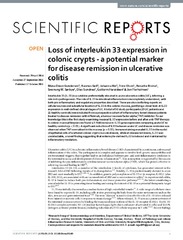Loss of interleukin 33 expression in colonic crypts- a potential marker for disease remission in ulcerative colitis
Permanent lenke
https://hdl.handle.net/10037/9868Dato
2016-10-17Type
Journal articleTidsskriftartikkel
Peer reviewed
Forfatter
Gundersen, Mona Dixon; Goll, Rasmus; Hol, Johanna; Olsen, Trine; Rismo, Renathe; Sørbye, Sveinung Wergeland; Sundnes, Olav; Haraldsen, Guttorm; Florholmen, JonSammendrag
Interleukin 33 (IL-33) is a cytokine preferentially elevated in acute ulcerative colitis (UC), inferring a role in its pathogenesis. The role of IL-33 in intestinal inflammation is incompletely understood, with both pro-inflammatory and regulatory properties described. There are also conflicting reports on cellular sources and subcellular location of IL-33 in the colonic mucosa, justifying a closer look at IL-33 expression in well-defined clinical stages of UC. A total of 50 study participants (29 UC patients and 21 healthy controls) were included from a prospective cohort of inflammatory bowel disease patients treated to disease remission with infliximab, a tumour necrosis factor alpha (TNF) inhibitor. To our knowledge this is the first study examining mucosal IL-33 expression before and after anti-TNF therapy. In colonic mucosal biopsies we found a 3-fold increase in IL-33 gene expression comparing acute UC to healthy controls (p < 0.01). A significant reduction of IL33 between acute UC and disease remission was observed when TNF normalised in the mucosa (p = 0.02). Immunostaining revealed IL-33 in the nuclei of epithelial cells of scattered colonic crypts in acute disease, while at disease remission, IL-33 was undetectable, a novel finding suggesting that enterocyte-derived IL-33 is induced and maintained by inflammatory mediators.


 English
English norsk
norsk